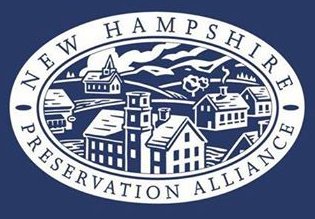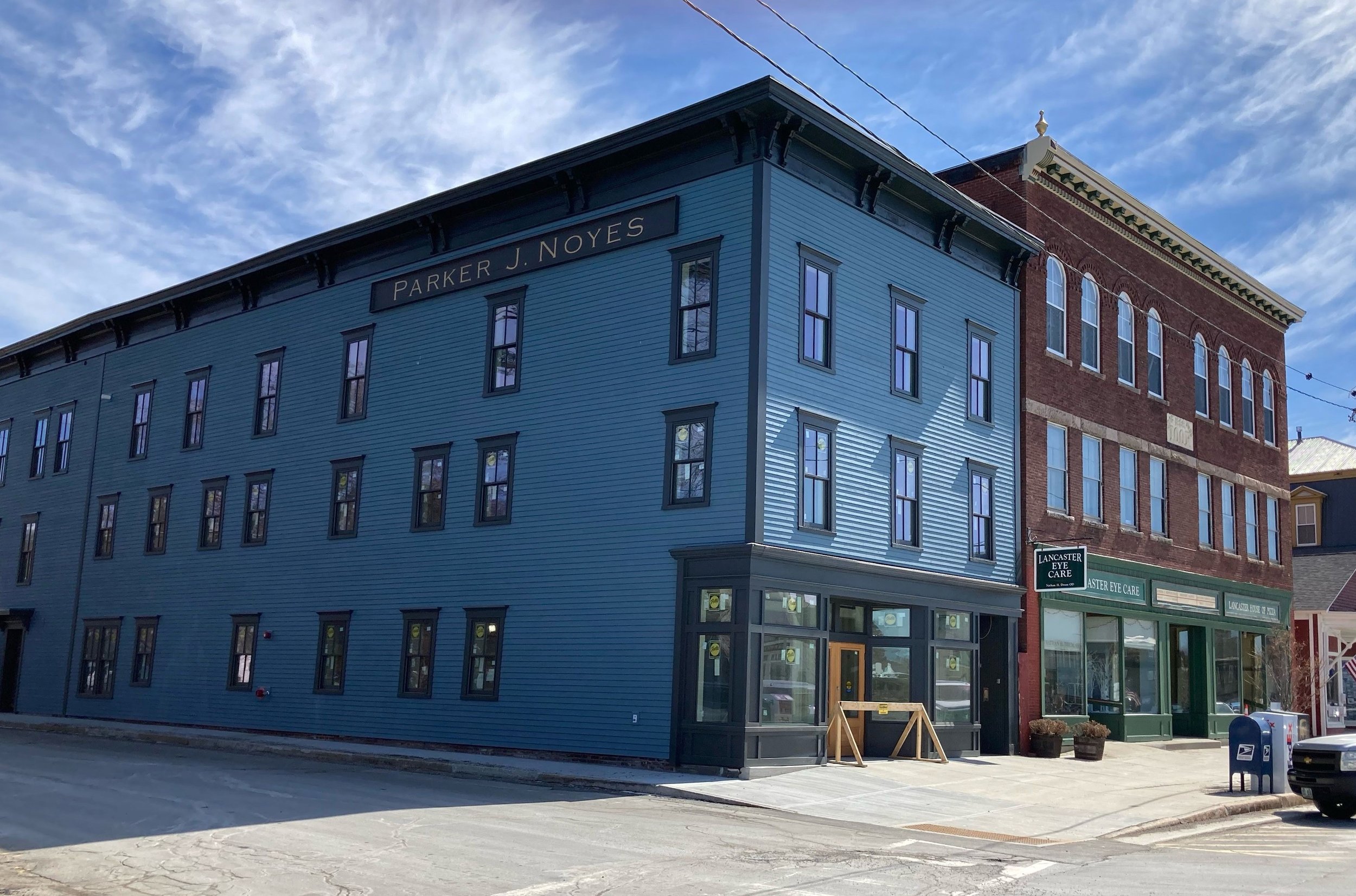Seven to Save 2017 Recap
With 2022’s Seven to Save announcement coming up, we wanted to showcase updates from previous listees. This week, we’re looking back five years ago to 2017.
That year, friends and preservation colleagues gathered in Wolfeboro, where we celebrated that town’s remarkable rehabilitation of its town hall (itself a Seven to Save listee and eventual Preservation Achievement Award winner) and toured the nearby Pickering House (also a Seven to Save listee and award winner), train station, and adjacent freight shed.
2017’s list included some doozies. Each project benefitted from Preservation Alliance services, including legal assistance, late night meetings, letter writing campaigns, grant assistance, and planning help. Let’s look at where are they now:
Grafton Center Meetinghouse, Grafton
This visible 18th century landmark on Route 4 in Grafton Center had been severely damaged in a January 2016 fire. Following the Seven to Save listing, a regional nonprofit formed to negotiate the building’s sale, which was complicated by back taxes and liens. Mascoma Valley Preservation successfully purchased the meetinghouse and to date has raised one million dollars towards its rehabilitation as a general store and community hall.
That rehabilitation is ongoing, but thanks to timber framer JR Graton, the building rests on a new foundation, is structurally sound, and its envelope nearly enclosed for the first time in over six years. Before the end of the year, the meetinghouse is expected to be painted and have its second story windows installed – windows custom made and then glazed by Mascoma Valley Preservation board members and volunteers using salvaged glass.
The next phase will focus on interior work – plaster repair, systems installation, and woodwork.
For more information, visit: https://mascomavalleypreservation.org/
St. Joseph Catholic Church, Bartlett
In 2016, the Bartlett School District planned to raze the former Catholic Church next door to the elementary school. The District had purchased the building after parishes were consolidated in the Mount Washington Valley, but soon found that the lead, mold, and asbestos abatement alone was too costly.
The Bartlett Historical Society (BHS) stepped up to convert the building, which had served the spiritual needs of the area’s mostly immigrant families when constructed in 1890, into their new headquarters and museum.
Since 2017, the BHS has raised over $400,000 from over 400 donors and negotiated for the purchase of the property. Guided by a historic building assessment, the undersized and failing roof trusses were replaced and the interior plaster – too damaged after more than a decade of water damage – was removed. This left a shell of a building, but a structurally sound one.
Additional work includes the installation of a new HVAC system, rockwool insulation, and electrical wiring. Closer assessment of the stained glass windows, which were installed in the decades after the church’s construction as memorial gifts, revealed that they would need complete restoration. The BHS decided to install era-appropriate windows in their place and display the stained glass in custom-designed LED light boxes on the interior.
When it came time to remove the vinyl siding, more costly surprises were in store. Much of the original clapboards were rotted from decades of water infiltration, necessitating the entire removal of the north and south elevations’ clapboards and some sheathing, even after airing out and bleach solutions were applied.
Says president Phil Franklin, the pandemic affected progress and the budget, which is now $200,000 more than what they originally estimated. The group’s dedicated general contractor and volunteers have been instrumental in navigating the volatile materials market and keeping costs down.
As funding allows, next steps include finishing the interior and removing the vinyl siding on the two remaining elevations. Interior trim and wainscot will be returned and painted the original color, based on physical evidence found during the construction process.
For more information, visit: https://www.bartletthistory.net/museum-introduction-page
Hope Engine Company No. 1, Hinsdale
Call it the little engine house that almost could.
Using the momentum after the 2017 announcement, this small timber frame engine house – built in c.1855 for a private fledgling fire department in the industrial village – was relocated to a downtown lot thanks to the generosity of a preservation-minded neighbor. This initial move saved the building from demolition while a plan could be devised.
When that neighbor decided to sell his property, the engine house had to be moved once more in 2021, this time to the front lawn of the project’s champion, Donna Suskawicz.
Small things are being done while the engine house looks for a new permanent home, ideally in downtown Hinsdale. A planning study with cost estimates was conducted, some windows have been restored, and the historic sign reading “Hope Engine Co. No. 1” is being reproduced. Conversations are ongoing about exactly where the small building can move to – so far, vacant lots owned by the town, Congregational Church, and VFW have not panned out.
A less ideal, but increasingly likely, option is to relocate the building to another town.
For more information, contact the Preservation Alliance.
French-Taylor House, Moultonborough
Sometimes, despite best efforts, significant endangered buildings don’t make it.
This was the case with the French-Taylor House. The Town of Moultonborough purchased the 5-acre property in 2014 and the Heritage Commission worked for years to save this Village landmark. The Commission had the building listed to the State Register of Historic Places, received grants for building condition and barn assessments, worked on finding potential buyers, and lobbied the town to repair the leaking roof.
The Taylor House was discussed in numerous planning studies and reports, including the Master Plans of 2008 and 2021, the Plan NH Charrette of 2012, and the Village Vision Report that was endorsed at Town Meeting in 2015. More recently, the Plan NH Charrette of 2018 and the UNH First Impressions assessment of 2019 encouraged sale and rehabilitation of the house to bolster economic revitalization in the village area.
Following an RFP process and six-month property listing, and two potential buyers withdrawing offers, town leaders voted in July 2021 to demolish this community asset, without a public hearing on the matter. This decision was at odds with the directive given at Town Meeting just months earlier. The site is now a grassy void at the center of Moultonborough Village.
Efforts by concerned citizens, the Preservation Alliance and the NH Division of Historical Resources, James Garvin’s Report on the French-Taylor House, and the ‘Save This Old House’ for sale feature in This Old House in early 2020 did not help in this case. Heritage chair Cristina Ashjian noted how its “demolition runs counter to all defined community planning, economic development, and heritage goals for the Village.”
Gale School, Belmont
In 2017, the Save Our Gale School group was a decade into trying to save this 1894 landmark. Just weeks before the 2017 list was announced, the Shaker Regional School District – anxious to remove the vacant building from its campus – solicited proposals for the building’s demolition or relocation.
Save Our Gale School submitted the only proposal. Without a concrete idea of where the 200-ton building would go, the group committed to relocating the structure by the summer of 2018, a date later pushed to the summer of 2019. At the 2018 school annual voting session, voters approved the sale by an overwhelming majority.
With new momentum, the group roped in new members and started raising funds to supplement the district’s $70,000 allowance (the amount set aside for the building’s demolition). Thanks to the generosity of a Gale School alum who owned a vacant lot nearby and the partnership of Lakes Region Community Developers, Geddes Moving relocated the structure over the course of two days in the summer of 2020.
Today, the building rests on a new foundation and is preparing for its new life as a center for community services.
It’s a story of incredible perseverance, a bold investment by LCHIP, and the dedication of countless individuals.
Tax credits are now available for the school’s redevelopment. Learn more here: Gale School Fundraising - Lakes Region Community Developers (lrcommunitydevelopers.org)
B&M Freight Shed
This colonial revival freight shed, built from the ashes of a devastating fire that leveled downtown Canaan in 1923, is about to celebrate 100 years. The freight shed is one of the most intact buildings in a downtown that was planned to be a modern and model colonial revival village.
When the building was listed to Seven to Save, the Town of Canaan was engaged in an ownership and property tax dispute with the previous owner and his lawyer. In the years since, the Town has come to own the building outright. Mascoma Valley Preservation, the same group responsible for the Grafton Center Meetinghouse rehabilitation, is working with the Town to rehabilitate the piece of railroad history.
To date, MVP volunteers and Town crews have cleared the vegetation away from the building. MVP has secured two Mooseplate grants to address the envelope; the first to repair the leaking slate roof and the second to replace rotted sills around the perimeter.
Next steps are to repair and paint the most visible and worst elevations, a project that will hopefully transpire in 2023 in time for the building’s centennial.
For more information, visit: https://mascomavalleypreservation.org/
Parker J. Noyes Block, Lancaster
It’s almost difficult to remember the first few site visits to the Parker Noyes Block in downtown Lancaster now that the building’s rehabilitation has won a Preservation Achievement Award.
Several times, Preservation Alliance staff met with the town and the owner of the property, hoping to find a solution that met the owner’s needs and the town’s goals. After the 2017 Seven to Save listing, a local developer and the Northern Forest Center stepped forward as a buyer, hoping to rehabilitate the building and add housing to Main Street.
The Northern Forest Center chose the preservation route, hoping to take advantage of grant funding and Lancaster’s downtown revitalization tax credit (79-E). Despite pandemic bottlenecks, surging prices, and labor shortages, the project was completed in the spring of 2022. Today, the six apartments are occupied and the first floor commercial space is about to open as the expanded Root Seller, the marketplace arm of the local nonprofit, Taproot.
According to Dickie Mackillop, the previous owner who grew up roller skating on the third floor and working on the first floor, “I’m so pleased and grateful with the project…just thrilled. When I drive along Main Street, I see a continuous row of preserved buildings…it’s like a postcard.”
For more information, visit: https://northernforest.org/ and https://www.taprootnh.org/marketplace-1
Our annual Seven to Save list recognizes historic properties in imminent need of assistance. Learn more about the program here.







